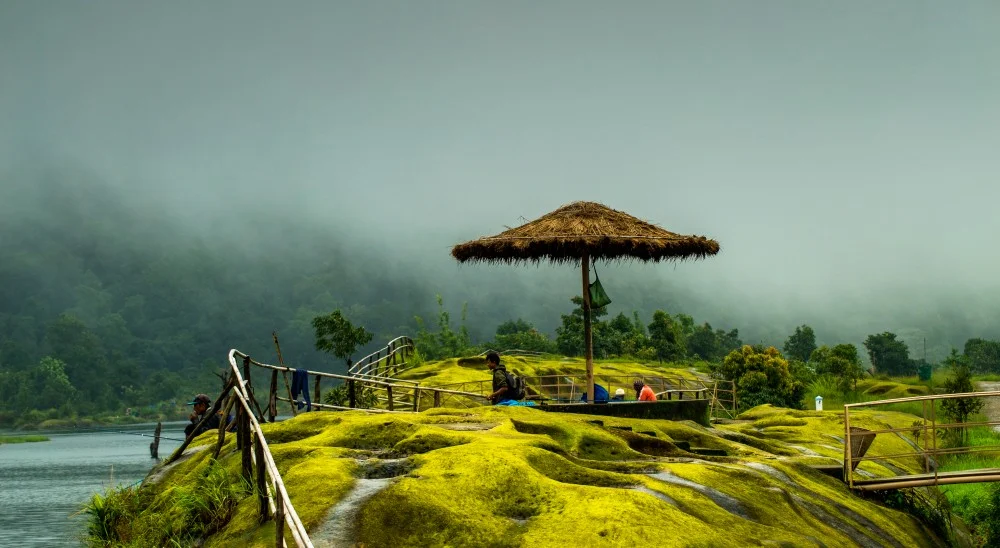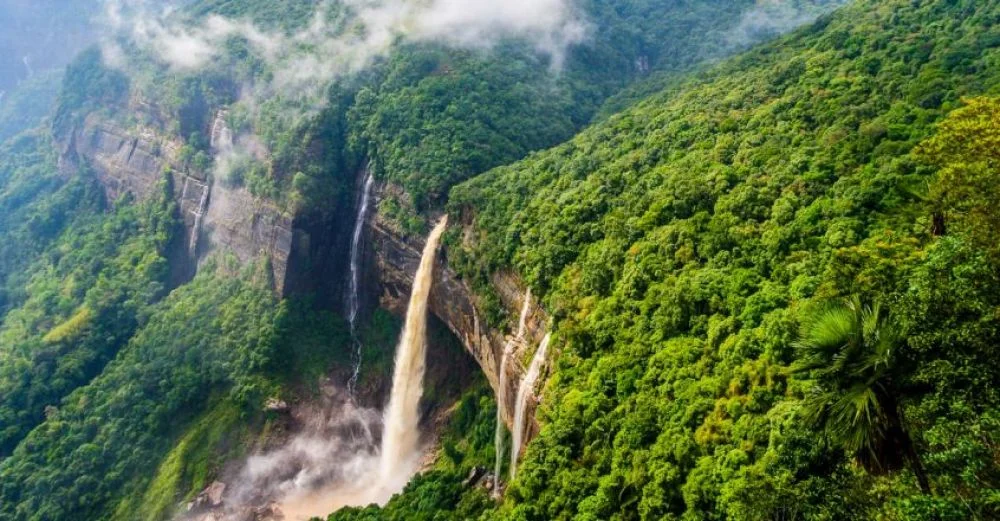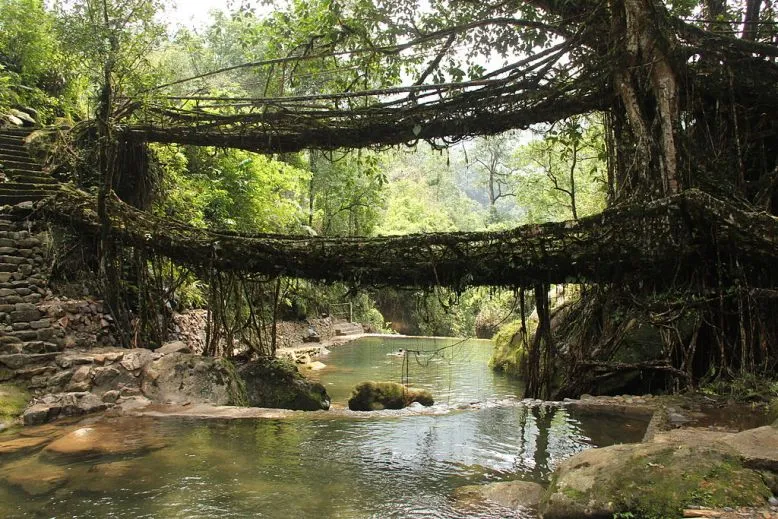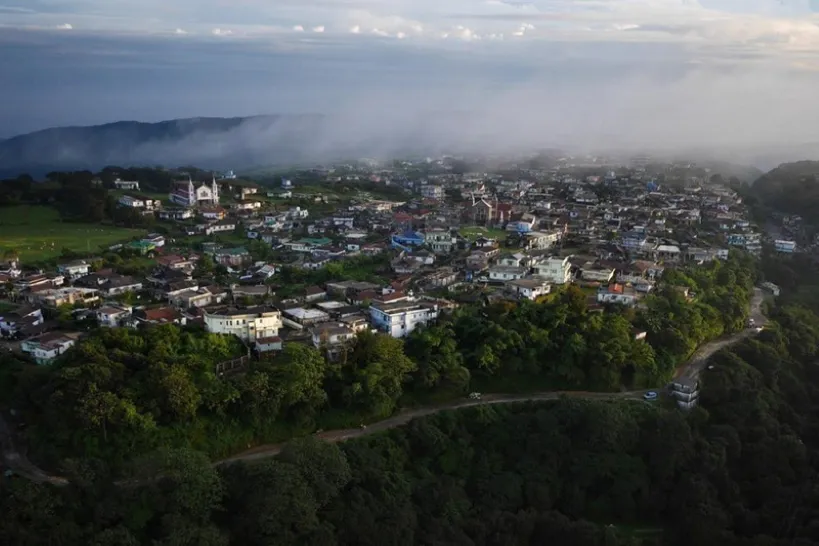Mawsynram in Meghalaya: The Wettest Place on Earth and Nature’s Paradise
Meghalaya’s Mawsynram, the rainiest place in the world, gets an amazing 11,871 mm (467 inches) of rain in a year and is a one-of-a-kind natural phenomenon. Situated within the East Khasi Hills district, the scenic village owes its contours to incessant monsoon rains driven by the Bay of Bengal winds and the rugged hill landscape of this region. Despite the harsh weather, the Khasi people have been resilient and have adapted to grass-roofed homes and bamboo rain shields. This nature lover’s paradise features stunning waterfalls, ancient limestone caves, and renowned living root bridges. The tourists get to witness the untamed beauty of this rain-drenched destination while discovering its rich culture and green landscapes. Whether you are looking for adventure or just want to see nature at its best, Mawsynram in Meghalaya offers an experience one will never forget in one of the most offbeat locations on earth.
Book here Meghalaya Tour Packages.
Geography & Climate of Mawsynram in Meghalaya
Mawsynram in Meghalaya is a small village in the East Khasi Hills district, about 60 km from Shillong, known for being the wettest place on Earth. Situated at an elevation of 1,400 meters, it is surrounded by lush hills, deep valleys, and dense forests. The region experiences a subtropical highland climate, with heavy monsoon rains influenced by moisture-laden winds from the Bay of Bengal. It records an annual rainfall of 11,871 mm (467 inches), with the heaviest downpours occurring from June to September. The Khasi Hills trap these monsoon winds, resulting in continuous rainfall that shapes the landscape. Winters in Mawsynram are cool and misty, providing a refreshing break from the extreme rains.
Causes of Heavy Rainfall in Mawsynram in Meghalaya
1. Geographical Location – Positioned in the East Khasi Hills, directly in the path of monsoon winds.
2. Bay of Bengal Moisture – Monsoon winds from the Bay of Bengal carry heavy moisture to the region.
3. Orographic Rainfall – Hills force winds to rise, cooling the air and causing continuous heavy rainfall.
4. Funnel-shaped valleys – Trap clouds, intensifying rainfall by concentrating moisture in one area.
5. Prolonged Monsoon Season – From June to September, constant circulation leads to excessive rain.
6. Dense Vegetation – Thick forests help retain moisture, contributing to frequent and intense showers.
Tourist Attractions in Mawsynram in Meghalaya
1. Mawsmai Caves

Mawsmai Caves are a fascinating natural wonder in Mawsynram, known for their breathtaking limestone formations. The caves are adorned with stalactites and stalagmites, creating a mesmerizing underground landscape. With well-lit interiors and narrow passages, they provide an exciting experience for adventure seekers. These caves are one of the most accessible in the region, allowing visitors to witness Meghalaya’s stunning geology. A visit here offers a glimpse into the mysterious underground world shaped by centuries of water erosion.
2. Mawlyngbna Village

Mawlyngbna Village is an emerging eco-tourism hotspot in Mawsynram, offering a mix of nature, adventure, and history. It is known for its prehistoric fossils, crystal-clear rivers, and lush greenery. Tourists can enjoy activities like kayaking, trekking, and zip-lining while exploring the rich biodiversity. The village also has natural springs and hidden waterfalls, making it a serene getaway. With its unspoiled beauty and rich Khasi heritage, Mawlyngbna is a must-visit for nature lovers.
3. Nohkalikai Falls

Nohkalikai Falls, located near Mawsynram, is one of India’s tallest waterfalls, plunging from a height of 340 meters (1,115 feet). Surrounded by misty cliffs and green valleys, the falls create a stunning sight, especially during the monsoon season. The name “Nohkalikai” is linked to a tragic Khasi legend, adding an emotional touch to its beauty. A viewpoint near the falls provides a breathtaking panoramic view of the cascading waters. This majestic waterfall is a perfect place for photography and relaxation amidst nature.
4. Living Root Bridges

The Living Root Bridges of Mawsynram is an incredible example of sustainable engineering by the Khasi tribe. These bridges are formed by training the aerial roots of rubber trees across rivers and streams. Over time, they grow stronger and last for centuries, providing a natural alternative to wooden or steel bridges. Tourists can trek through the dense forests to witness these bioengineered marvels. These bridges are not just a sight to behold but also a testament to the harmony between nature and human ingenuity.
5. Mawsynram Village

Mawsynram Village itself is a unique attraction, known for being the wettest place on Earth. Here, visitors can experience the true power of relentless monsoon rains, which shape the local lifestyle. The Khasi people have adapted to extreme weather with innovative bamboo rain shields and thick grass-roofed houses. Walking through the village offers a glimpse into traditional Khasi culture and rural life. The lush green surroundings and fresh air make it a perfect destination for those seeking peace and natural beauty.
Local Culture & Lifestyle of Mawsynram in Meghalaya
1. Khasi Tribal Community: The people of Mawsynram primarily belong to the Khasi tribe, known for their matrilineal society, where inheritance is passed through the mother’s side. Women play a central role in family life, and the community values tradition, hospitality, and strong social bonds.
2. Traditional Housing & Architecture: Homes in Mawsynram are built with thick grass roofs, bamboo, and wood to withstand heavy rainfall. Sloped roofs and elevated structures prevent water damage, reflecting the Khasi people’s adaptability to extreme weather.
3. Rain Protection & Clothing: Locals use knup, a handmade bamboo and banana leaf rain shield, to protect themselves from the monsoon rains. Traditional Khasi attire, including jainsem for women and symphony for men, showcases their unique cultural identity.
4. Food & Cuisine: The cuisine of Mawsynram features Jadoh (spiced rice with meat), Dohneiiong (pork with sesame), and Tungrymbai (fermented soybean paste). Smoked meats, wild greens, and betel nut (Kwai) are also commonly consumed in daily life.
5. Festivals & Celebrations: Festivals like Shad Suk Mynsiem, celebrating harvest and thanksgiving, and Behdienkhlam, for warding off evil, are widely observed. These celebrations include traditional dances, music, and rituals that preserve Khasi heritage.
6. Occupation & Livelihood: Agriculture is the main occupation, with locals growing rice, maize, betel leaves, and broom grass. Many are also involved in handicrafts, weaving, and eco-tourism, offering homestays and guiding visitors through the region.
Best Time to Visit Mawsynram in Meghalaya
The ideal period to visit Mawsynram is October to April, with pleasant weather and convenient travel. Winter (October to February) offers nice temperatures (10°C to 20°C) for sightseeing and trekking. Spring (March to May) offers flowering scenery and colorful Khasi festivals such as Shad Suk Mynsiem. Monsoon (June to September) makes Mawsynram a rain-soaked paradise with scenic waterfalls, best for rain enthusiasts but inconvenient for travel. Post-monsoon period (September to October) is a time of greenery and refreshed landscapes and hence a time to visit, refreshing.
Challenges & Adaptation in Mawsynram in Meghalaya
Challenges:
1. Heavy Rainfall and Flooding: The intense monsoons can lead to flash floods, which pose risks to infrastructure and livelihoods. Roads can become impassable, making transportation difficult and isolating communities.
2. Soil Erosion: The constant downpour accelerates soil erosion, which can lead to loss of arable land and negatively impact agriculture, the mainstay of the local economy.
3. Infrastructure Strain: The continuous heavy rain puts a strain on existing infrastructure, requiring frequent repairs and enhancements to drainage systems, roads, and buildings.
4. Health Issues: The wet environment fosters the proliferation of waterborne diseases and puts communities at risk of conditions such as malaria and dengue due to increased mosquito breeding.
5. Agricultural Challenges: While rainfall is beneficial for some crops, excessive moisture can lead to crop damage and hinder certain agricultural practices, requiring farmers to adapt their methods.
Adaptation Strategies:
1. Improved Water Management: Implementing better drainage systems and rainwater harvesting can help manage excess water and mitigate flooding impacts.
2. Erosion Control Techniques: The use of contour farming, terracing, and planting cover crops can help reduce soil erosion and maintain soil fertility.
3. Diversification of Crops: Farmers are encouraged to diversify their crops to include varieties that are more resilient to waterlogging and changing weather patterns.
4. Community Preparedness: Local communities are increasingly focusing on disaster preparedness and response plans to effectively deal with the challenges posed by extreme weather conditions.
5. Research and Education: Collaborating with research institutions to study climate impacts and providing education on sustainable practices can empower local farmers and communities to adapt better.
Conclusion
In conclusion, Mawsynram in Meghalaya is an amazing place, with record-breaking rain, breathtaking scenery, and a rich Khasi heritage. Despite the adversity presented by extreme weather conditions, the resourceful local population has overcome it through creative architecture, eco-friendly farming, and indigenous rain-protection strategies. Its majestic waterfalls, dense forests, and extraordinary living root bridges turn it into heaven for nature enthusiasts and adventure seekers. Though monsoon months reveal Mawsynram’s unrivaled splendor, October to April is the ideal time to visit, when traveling is convenient. Whether discovering its vibrant culture, venturing into eco-tourism, or witnessing the world’s wettest location, Mawsynram provides an unforgettable sojourn into nature’s unbridled grandeur.
Here you can also check our Meghalaya Tour Packages.
People also ask about the Mawsynram in Meghalaya
1. Why is Mawsynram in Meghalaya famous?
Mawsynram is famous for receiving the highest annual rainfall in the world, making it the wettest place on Earth. It is also known for its stunning waterfalls, living root bridges, and lush green landscapes.
2. What is the best time to visit Mawsynram in Meghalaya?
The best time to visit is from October to April when the weather is pleasant and ideal for sightseeing. Monsoon (June to September) is mesmerizing but can make travel difficult due to heavy rainfall.
3. How do people in Mawsynram adapt to heavy rainfall?
Locals use traditional bamboo rain shields (knup), build houses with sloped roofs, and practice terrace farming to prevent soil erosion. Many also rely on eco-friendly and sustainable living practices.
4. What are the top tourist attractions in Mawsynram?
Major attractions include the Mawsmai Caves, Nohkalikai Falls, Mawjymbuin Cave, Living Root Bridges, and lush green hills that make it a paradise for nature lovers.
5. How can I reach Mawsynram?
The nearest airport and railway station are in Guwahati, Assam, around 150 km away. From there, visitors can hire a taxi or take a bus to reach Mawsynram.
6. What kind of food is available in Mawsynram?
Khasi cuisine dominates the region, with popular dishes like Jadoh (spiced rice with meat), Dohneiiong (pork with sesame), and Tungrymbai (fermented soybean paste). Local fresh produce and smoked meats are widely consumed.
7. Is it safe to travel to Mawsynram during monsoon?
While monsoon enhances the natural beauty of Mawsynram, travel can be challenging due to landslides, roadblocks, and heavy rains. It is advisable to check weather conditions and road accessibility before visiting.
8. What kind of accommodation is available in Mawsynram?
Mawsynram offers homestays, guesthouses, and eco-lodges, allowing visitors to experience local hospitality and culture. Nearby Shillong also has a variety of hotels for tourists.
9. What cultural experiences can I have in Mawsynram in Meghalaya?
Visitors can experience Khasi festivals, traditional music, local handicrafts, and eco-tourism activities, along with the warm hospitality of the Khasi community.
10. Is Mawsynram worth visiting?
Absolutely! Mawsynram is a nature lover’s paradise, offering breathtaking landscapes, unique cultural experiences, and the thrill of witnessing the wettest place on Earth.
